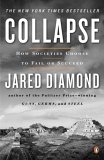Summary | Excerpt | Reading Guide | Reviews | Beyond the Book | Readalikes | Genres & Themes | Author Bio

Critics' Opinion:
Readers' Opinion:
First Published:
Dec 2004, 575 pages
Paperback:
Jan 2006, 592 pages
 Book Reviewed by:
Book Reviewed by:
BookBrowse Review Team
Buy This Book
Natural climate changes may make conditions either better or worse for any
particular human society, and may benefit one society while hurting another
society. (For example, we shall see that the Little Ice Age was bad for the
Greenland Norse but good for the Greenland Inuit.) In many historical cases, a
society that was depleting its environmental resources could absorb the losses
as long as the climate was benign, but was then driven over the brink of
collapse when the climate became drier, colder, hotter, wetter, or more
variable. Should one then say that the collapse was caused by human
environmental impact, or by climate change? Neither of those simple alternatives
is correct. Instead, if the society hadn't already partly depleted its
environmental resources, it might have survived the resource depletion caused by
climate change. Conversely, it was able to survive its self-inflicted resource
depletion until climate change produced further resource depletion. It was
neither factor taken alone, but the combination of environmental impact and
climate change, that proved fatal.
A third consideration is hostile neighbors. All but a few historical
societies have been geographically close enough to some other societies to have
had at least some contact with them. Relations with neighboring societies may be
intermittently or chronically hostile. A society may be able to hold off its
enemies as long as it is strong, only to succumb when it becomes weakened for
any reason, including environmental damage. The proximate cause of the collapse
will then be military conquest, but the ultimate cause—the factor whose change
led to the collapse—will have been the factor that caused the weakening. Hence
collapses for ecological or other reasons often masquerade as military defeats.
The most familiar debate about such possible masquerading involves the fall
of the Western Roman Empire. Rome became increasingly beset by barbarian
invasions, with the conventional date for the Empire's fall being taken
somewhat arbitrarily as a.d. 476, the year in which the last emperor of the West
was deposed. However, even before the rise of the Roman Empire, there had been "barbarian" tribes who lived in northern Europe and Central Asia beyond the
borders of "civilized" Mediterranean Europe, and who periodically attacked
civilized Europe (as well as civilized China and India). For over a thousand
years, Rome successfully held off the barbarians, for instance slaughtering a
large invading force of Cimbri and Teutones bent on conquering northern Italy at
the Battle of Campi Raudii in 101 b.c.
Eventually, it was the barbarians rather than Romans who won the battles:
what was the fundamental reason for that shift in fortune? Was it because of
changes in the barbarians themselves, such that they became more numerous or
better organized, acquired better weapons or more horses, or profited from
climate change in the Central Asian steppes? In that case, we would say that
barbarians really could be identified as the fundamental cause of Rome's fall.
Or was it instead that the same old unchanged barbarians were always waiting on
the Roman Empire's frontiers, and that they couldn't prevail until Rome
became weakened by some combination of economic, political, environmental, and
other problems? In that case we would blame Rome's fall on its own problems,
with the barbarians just providing the coup de grâce. This question continues
to be debated. Essentially the same question has been debated for the fall of
the Khmer Empire centered on Angkor Wat in relation to invasions by Thai
neighbors, for the decline in Harappan Indus Valley civilization in relation to
Aryan invasions, and for the fall of Mycenean Greece and other Bronze Age
Mediterranean societies in relation to invasions by Sea Peoples.
The fourth set of factors is the converse of the third set: decreased support
by friendly neighbors, as opposed to increased attacks by hostile neighbors. All
but a few historical societies have had friendly trade partners as well as
neighboring enemies. Often, the partner and the enemy are one and the same
neighbor, whose behavior shifts back and forth between friendly and hostile.
Most societies depend to some extent on friendly neighbors, either for imports
of essential trade goods (like U.S. imports of oil, and Japanese imports of oil,
wood, and seafood, today), or else for cultural ties that lend cohesion to the
society (such as Australia's cultural identity imported from Britain until
recently). Hence the risk arises that, if your trade partner becomes weakened
for any reason (including environmental damage) and can no longer supply the
essential import or the cultural tie, your own society may become weakened as a
result. This is a familiar problem today because of the First World's
dependence on oil from ecologically fragile and politically troubled Third World
countries that imposed an oil embargo in 1973. Similar problems arose in the
past for the Greenland Norse, Pitcairn Islanders, and other societies.
From Collapse by Jared Diamond. Copyright Jared Diamond 2005. All rights reserved. No part of this book maybe reproduced without written permission from the publisher.





The Flower Sisters
by Michelle Collins Anderson
From the new Fannie Flagg of the Ozarks, a richly-woven story of family, forgiveness, and reinvention.

The House on Biscayne Bay
by Chanel Cleeton
As death stalks a gothic mansion in Miami, the lives of two women intertwine as the past and present collide.

The Funeral Cryer by Wenyan Lu
Debut novelist Wenyan Lu brings us this witty yet profound story about one woman's midlife reawakening in contemporary rural China.
Your guide toexceptional books
BookBrowse seeks out and recommends the best in contemporary fiction and nonfiction—books that not only engage and entertain but also deepen our understanding of ourselves and the world around us.